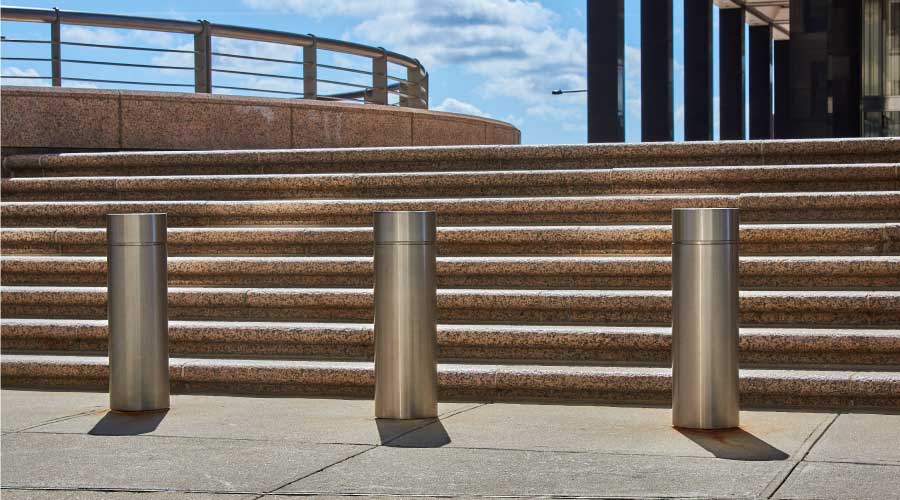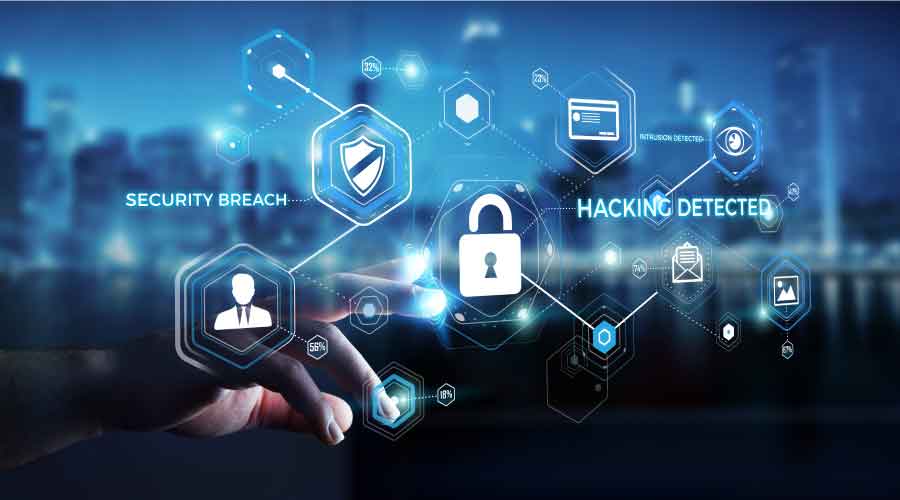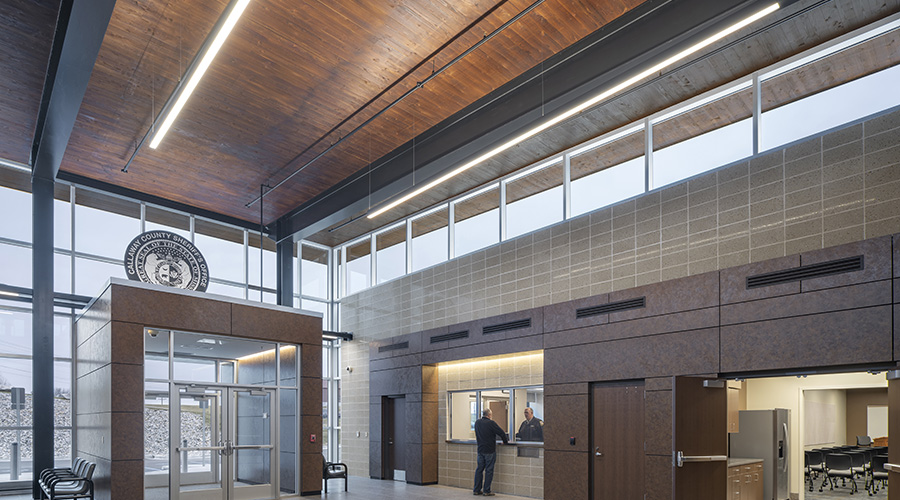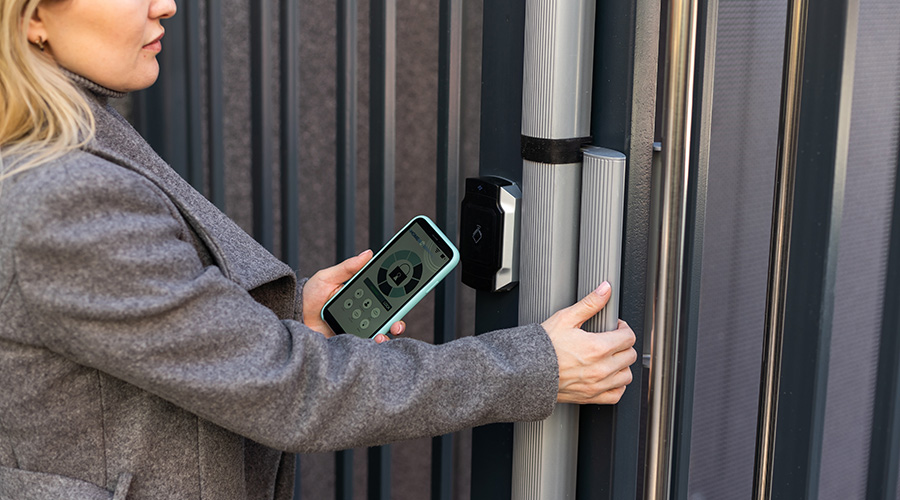What is ‘safe’?
By the evening of Sept. 11, 2001, it had become commonplace to observe that everything had changed. What wasn’t clear then — and in many respects isn’t clear today — is exactly how much buildings need to change. Already, as this special report shows, many things about buildings have been rethought: There are tighter procedures, more guards, steps to protect HVAC systems, some system upgrades, and a higher priority for security in budgets and the design process. But is all of that enough?
A big question is whether further changes should be mandated. New York City is evaluating significant new code requirements intended to make high-rises safer — proposals that could be a precursor to changes nationally. That prospect has some worried. Changes in building codes and standards in the wake of Sept. 11, says Building Owners and Managers Association International past president Sherwood Johnston, represent “potentially an enormous new threat.”
Certainly, the costs of new measures could be high. A recent report from Gensler, an architecture firm, notes that the federal government spent $1.2 billion following the Oklahoma City bombing to protect federal facilities against truck bombs. Is it simply a waste of money to take measures to thwart attacks that never come? Certainly not. No one buys term life insurance hoping the benefits will be paid out.
What’s more, security improvements are more than insurance. Hardened buildings are less inviting targets. But how much is deterrence worth?
The debate about safety and security must sort out difficult questions like that. Are current measures adequate? Should a timetable be imposed? Who should have the final say?
It will be years before those issues are resolved; this special report looks at where things stand today. It examines changes being made in different types of buildings, explains how and why codes might change, and details new approaches that could improve fire and life safety.
Seeking a New Status Quo
Across the nation, security in the wake of Sept. 11 is an uneasy balancing act involving risk, cost, openness and measures already in place
For Most Buildings, A Measured Response
Tightening procedures is most common step; completing major upgrades will take time
In the immediate aftermath of Sept. 11, 2001, building owners faced a wave of safety and security questions. From CEOs to school boards, top management demanded to know how vulnerable their facilities were to attack. Tenants, normally averse to restrictions on their freedom, wanted more security. Insurers began demanding security assessments. “Target hardening” — a military term that was expanded to cover a broad range of safety and security features — became part of the real estate lexicon and helped create a sense of urgency.
“There was an overreaction following Sept. 11,” says Robert Cizmadia, director of corporate security services with Gage-Babcock and Associates. “Owners immediately wanted to secure their buildings and spend money on technology. But many were doing this without fully assessing their current capability against potential threats.”
Fast-forward one year. The rush to harden buildings has waned, and a new phrase has entered the lexicon: “measured response.” Much of any new investment is going for personnel or quick fixes to building security systems, security sources say. If new design or technological solutions are needed, owners are thinking long term, both in budget and implementation.
For now, there is no doubt that security assessments are the number one priority. Ross Bulla, president of The Treadstone Group, says he went from performing an average of about 25 assessments a year to 75 so far this year.
At this point, those assessments haven’t led to major changes in the majority of buildings. One reason is that most large buildings already have fairly significant security systems. Most owners say their existing systems are fairly sound, requiring mostly tweaks and upgrades. And owners who believe their buildings face greater risks have made changes, sometimes major changes.
What if the assessment recommends upgrades to the existing system? “It depends on whether the results are affordable and whether they meet the company’s culture,” Cizmadia says.
An initial wave of security spending following Sept. 11 was short lived, says Lauris Freidenfelds, vice president of Sako and Associates; now, if security budgets do increase, the amounts are not significant. Instead, owners are looking within the existing budget for ways to afford design and technology changes down the road. “Think of 2002 as the year for assessments and 2003 to 2005 or 2006 as the years of implementation,” says Freidenfelds.
The good news is that phased implementation is giving security a line-item status in budgets and capital plans that it never had before and making it a higher priority for action than some other capital budget items. When security projects are rolled into a capital budget for improvements, they can be quite affordable, Cizmadia says. What’s more, widespread security assessments have also spurred interest in security master plans.
There may be another reason for today’s go-slow approach, says Thom Bogle, director of corporate services for Ernst and Young and chair of the firm’s task force on security threat assessment. “I think owners aren’t doing much now because they are waiting for the other shoe to drop.” Another attack could lead to a surge in spending.
Taking Action Today
It’s important to recognize that even today building owners are taking a range of steps to improve safety and security. One measure that is becoming more common is hiring in-house security directors, whose job in part may be organizing and conducting a security assessment. That would take the cost of assessment, which can range from less than $10,000 to costs in the six figures, in-house as well. This in-house person is also acting as a liaison between the owner, outside law enforcement officials and building tenants or occupants.
Physical changes are also being made in buildings. One goal is to further define the point of demarcation in the lobby between visitor and tenant or occupant. Tactics include installing devices to physically direct traffic, adding signage, putting in additional turnstiles and creating separate entrances.
What’s more, the security-conscious U.S. General Services Administration is having a 600-pound-gorilla effect on other market sectors. “Speculative developers are now asking us to help them make their buildings meet GSA’s standards,” says Don Ghent, senior associate and technical director for the southeast region for Gensler. “The government is making the private sector safer.”
— David Kozlowski, senior editor
Assessing Threats is First Step, Experts Agree
Security assessments are a top priority since the terrorists attacks last September — or should be — say security experts.
Security assessments combine quantitative and qualitative analyses of a facility’s assets and potential threats. Much of the necessary data can be drawn from the facility itself and from local law enforcement agencies. A security assessment is usually composed of four parts: asset, threat, vulnerability and risk analyses.
“If building owners have not yet reassessed their buildings’ security, they need to have it done because they will be liable for security,” says Ross Bulla, president of The Treadstone Group. “The standards in what is reasonable and foreseeable have changed since Sept. 11.”
It’s important to conduct assessments regularly, and not all of the reasons have to do with security. “We try to plan security upgrades with other renovations or retrofits,” says Wade Belcher, director of security for the Office of the Architect at the U.S. General Services Administration. “This helps reduce the costs of retrofitting for security systems.”
In the past, it was all too common for security assessments to sit on a shelf and gather dust. That’s still happening, says David Aggleton, president of Aggleton and Associates. “That may be one of the most dangerous things an owner can do from both a security standpoint and a liability standpoint.”
— David Kozlowski, senior editor
High-Rise Security Risks Vary Building by Building
Existing systems and policies get fine tuned; some buildings look to technology for answers
First, the obvious: Nothing would have stopped what happened to the Pentagon or the World Trade Center on Sept. 11, short of better airport security.
A second point is also obvious: High-profile high-rises are at greater risk of terrorist attack than other types of office buildings, even other office towers. For prominent buildings, extensive security precautions are often justified — and, in many cases, already have been taken.
But for most office buildings, even most high-rises, the lesson of Sept. 11 is far less clear. Is a major overhaul of the security system justified? Most building owners and facility executives have concluded that the answer is “no.” Even in those cases, however, there a number of things that can be done to prevent or minimize threats or actual harm to people and property. At the top of the list is making sure the current security system is operating at its full potential.
“Most facility executives think security protection is something you design and implement and then you can forget about,” says Freidenfelds of Sako and Associates. “Well, security systems are dynamic. They have to be maintained and adjusted as conditions change.”
The most pervasive changes in the industry involve security procedures and access control. For instance, some owners now enforce a long-ignored requirement that visitors go to a central location or guard desk for passes or badges before entering.
Controlling Building Access
Not surprisingly, procedures and security systems for loading docks, mailrooms and alternative entranceways into high-rise buildings have become a major focus. For example, many experts say the trend is to limit or eliminate internal delivery of packages unless vendors are screened or internally cleared. Otherwise, uniformed personnel or tenants themselves deliver the packages.
Other changes have to do with technology. After the terrorist attacks, long lines formed when security personnel were attempting to stop everyone coming into a building. One solution that has drawn a good deal of interest is optical turnstiles, which can handle thousands of people in the morning rush effectively and efficiently, says Terry Gillick, vice president of Syska Hennessy Group.
Optical turnstiles are especially popular for high-rise buildings, says David Aggleton, president of Aggleton and Associates. They will grant access to 45 to 60 people per minute per unit and cost about $20,000 to $30,000 per lane, he says. By comparison, standard mechanical turnstiles cost about $6,000 per lane. Optical units take up a lot of room, so lobby space can be an issue.
Owners and security professionals are also reporting greater use of card systems, especially proximity cards.
Andy Nick, principal with Taconic Investment, owns a 2.8-million-square-foot office building in Times Square. Tenant interest in security led him to install an integrated card access system that controls entry into the building, elevators, package-control centers and anywhere else access is needed, he says. A tenant who forgets his or her badge has to go to the visitor station to get into the building.
The attacks of Sept. 11 have driven other changes. For example, there is increasing interest in making tenants’ and owners’ access control systems compatible. “We are starting to see a lot more cooperation between large tenant security systems and building owner systems,” Gillick says.
CCTV systems are another focus of attention. Measures range from inexpensive tweaks — making sure CCTV cameras are provided with sufficient light or are properly positioned — to the installation of additional cameras in public areas, such as garden and reception spaces.
No Entry
Aggleton says he’s beginning to see a preference for messenger drop-off centers with entrances separate from the main entry lobby; there, internal personnel with security clearances can pick up the packages and deliver them. And, increasingly, food deliveries are received at the ground level only, and tenants are required to pick them up.
Although the building envelope is also receiving attention, major changes are not in the offing for most facilities. “There was a lot of talk initially about redesigning systems and envelopes, but everyone found out the costs were incredible,” says Steve Paulson, a vice president of national operations for Grubb and Ellis. If major work is needed on the building envelope, it is being incorporated into long-term capital plans.
One thing being done today, where owners believe there is a significant risk, is to install protective films on windows, Aggleton says. The application of so-called blast film helps contain flying glass in the event of an explosion. It can be relatively expensive, but not as expensive as replacing glazing with polycarbonate, an option being explored by some owners.
Before Sept. 11, most owners would not have considered the rooftops of their buildings to be security risks. However, some owners now believe HVAC systems on their roofs are vulnerable. As a result, some owners have secured access to their rooftops.
Down on the ground, the site for the building also offers some relatively inexpensive steps that building owners have been implementing. Barriers of various sorts are being installed to limit access to the building. Usually not aesthetically pleasing if simply plopped down, barriers can be worked into the landscape, Cizmadia says.
“Building owners are starting to look at integrating the landscape and site into the security design,” he says. Fountains and berms can keep cars and trucks away from the building. Different colors of pavement or the placement of plantings can help provide direction to visitors and create a sense of control. “The owner should use whatever is at his means to control the perception of access and security,” he says.
To determine what will provide the appropriate security response, building owners have to really consider each facility on its own merit.
“The national firms are not issuing any nationwide changes that I know of,” says Bogle of Ernst and Young. “Everything today in security is building by building. What’s an appropriate response? It depends. Is a building in an urban area? Is a building prominent? What is the tenant base? If none of these are a concern, then I see people relying on standard operating procedure with the appropriate tweaks.”
— David Kozlowski, senior editor
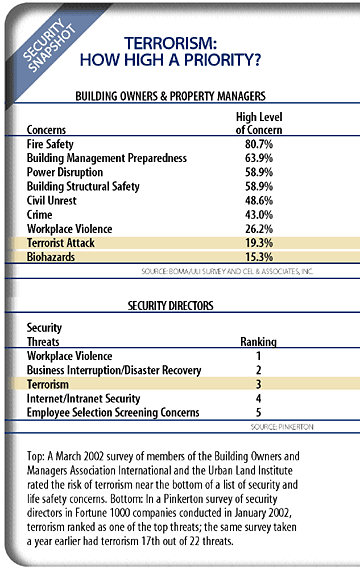
New Criteria Emerging for New Office Buildings
New high-rise office buildings of the post-Sept. 11 era could well include a host of features that enhance safety — and increase costs. New features include glazing and facades able to withstand blasts, additional structural reinforcements to withstand progressive collapses, and greater fire retardance. These measures could even become part of the standard methods of construction for prominent high-rises in major urban areas, even though such measures as blast-resistant windows and reinforced building skins will increase construction costs considerably.
Many observers also believe that high-rises — and the codes that govern their design — have not adequately addressed mass evacuation requirements. Stairwells tend to be too narrow, and there is a perception that there are not enough of them, even though a particular high-rise building may meet current code requirements on both counts. In addition, many high-rise stairwell doors open into the fire stairs, impeding passage and ultimately slowing evacuation. Solving these problems, however, often means reducing usable workspace. Many existing buildings cannot be retrofitted without major modifications, if it is possible at all.
In urban environments, increasing building setbacks and controlling street traffic are not always practical solutions to safeguarding major buildings. Outside of cities, some companies have started to look for very low-profile locations for their suburban and rural campuses and to distribute their assets in an effort to avoid complete corporate shutdown when a single building is out of service. These firms are opting to avoid major arteries and tuck themselves into the recesses of business parks. Remote locations provide more difficult targets, but they may also place operations farther away form labor sources, suppliers and customers. Many companies are also seeking sites that lie outside airport flight patterns.
Jeff Cosiol, PE, is a principal and project director at Kling Lindquist, an integrated architecture, engineering, interiors and planning firm.
For Some Facilities, Customers Can Complicate Planning
For malls, hotels and stadiums, some security measures could scare away patrons
In many facilities, discussions about security often revolve around the recurring theme of access control: Keep criminals out of areas where they could do harm. But what does a facility executive do when the purpose of the facility is to bring in as many people as possible?
In retail facilities, hospitality facilities and stadiums/arenas, one of the biggest indicators of success is how many people pass through the entrance. Overt security measures like armed guards and bollards risk scaring patrons away. So what can they do? In malls, the answer often involves new roles for security guards.
“Guards in malls have been like a cross between a school crossing guard and an information dispenser, almost like a host or hostess,” says Darrell Pattison, director of design for KA Inc.
Since Sept. 11, security guards are spending more time watching for suspicious characters and profiling. They are asking cars waiting along storefronts to move rather than linger. Guards are also keeping a close watch on automobiles going in and out of the site. Delivery trucks are also scrutinized more closely.
It’s not just guards whose roles are changing. “Building owners are working with tenants to help them understand the importance of security issues so they become self-policing communities,” says Ray Peloquin, a vice president at RTKL.
In another nod to subtlety, some newer malls are being built with bollards strategically placed and decorated to hide their true intentions. Fewer driveways that go straight up to store entrances and the addition of speed bumps are other discrete reminders of Sept. 11.
So far, the industry does not seem to be affected much by the terrorist attacks. Threats of mall bombings last Halloween did not deter shoppers, and a poll released this year by the International Council of Shopping Centers revealed that 75 percent of shoppers felt safe in malls last November, not much below the 83 percent score recorded in May 2002. Eighty-eight percent of shoppers did not change their habits after Sept. 11. Only 6 percent of shoppers say their main concern is terrorism, while 56 percent cite parking lot safety as their main shopping mall worry.
Nevertheless, more changes may be on the way. “In Israel, in the mall properties, they have people going through and checking garbage cans and suspicious packages,” says Pattison, who believes more American malls will also be undertaking this activity. Plainclothes security guards will also likely be used by many facilities.
Valet service, which is both a convenience to the shopper and a way to keep track of who is parking in a structure, may also become more popular. And signs that are posted around mall entrances regarding rules of conduct — “No shirt, no shoes, no service,” etc. — may start to look more like the signs posted at airports that run down the litany of things that may be used as weapons and are not allowed. But understated is still the rule — at least for now.
“If we have an event in the United States that targets a retail property, we will see people step up their security,” says Pattison. “That is the same thing that happened in Israel with the bombings. But it’s going to be something pretty ugly that causes us to get to that point.”
Hospitality: Putting on a Friendly Face
The last thing guests at a hotel or resort want to think about is whether the place they’re staying is secure.
“When someone checking in sees armed security guards and CCTV everywhere, they will probably not feel comfortable,” says Todd Lundgren, vice president and director of hospitality for RTKL.
To improve security without unnerving guests, hotels are taking a hard look at operating procedures. One step is to make sure that the bellhop is always outside and that someone is always at the front desk. Cars are not being allowed to idle out front. And while buses still bring people directly up to the front entrance, there is more emphasis on staff being there at these potentially critical times.
“It’s a training and human resources issue,” says Lundgren. “The staff is much more aware of what is going on around them, and they are making a stronger connection with guests.”
Subtle changes in facility design support a pervasive sense of self-policing. Instead of an imposing front desk, some hotels are moving to freestanding pods, which facilitate more interaction between the staff and guests. Hotels are also making sure that the front desk, in whatever form it takes, offers views of the front door and the elevators. Food and beverage areas have moved into the open.
Changes in other areas may also become more commonplace. Usually, stairwells open into the lobby of a facility. But what if a car crashes into the lobby? That risk may prompt some hotels to redirect stairwells to the back of the building. Also, many stairwells are built so that a person cannot exit on any floor except the lobby; today, many hotels are allowing an unlocked door every few floors.
What about the cost of added security measures? The balance between cost and security is shifting for many facility executives. “Now they feel there are certain things they have to do,” says Lundgren.
Stadiums: More Changes than People Realize
Of all the facilities that are designed to draw in paying customers, stadiums have instituted the most obvious changes. Many have added a level of screening before patrons reach the turnstiles and have limited items people can bring into the facility. Parking restrictions are now common; so are bollards around the facility.
But those changes are far from the whole story. “There is probably more going on in these facilities than most people know,” says Gordon Wood, a principal at Ellerbe Becket. Security experts are willing to talk about some of those measures. One example: Vendors are now being screened, which typically would not have been done before. “Back-of-the-house” spaces, which require I.D. for access, are also patrolled more tightly.
“There has been an expansion of the security envelope,” says Bulla of The Treadstone Group. Bulla cites one case where a railroad track goes by a stadium. Trains passing during the game are required to slow to 35 mph. In many stadiums, service points or intake areas for telecommunications, water, HVAC and electricity are being secured with barriers and gates.
What else is happening? For the most part, no one is saying. Not talking about security is one part of the security plan, says Wood.
— Angela Maas, managing editor
Shape of Hotels to Come?
Security concerns could change the kind of hospitality facilities built, says Todd Lundgren, vice president and director of hospitality for RTKL.
- Atrium hotels — Higher costs stopped many companies from building them. Now their openness, which makes people feel safer, may bring them back.
- Drive-to resorts — These resorts are located two to three hours from major cities; people can simply drive to them rather than needing to fly. They have experienced a newfound popularity in the past year, and Lundgren expects that to continue. Also, they are easier to get financed than more traditional resorts right now.
- Timeshares — Timeshares have not seen a fall in occupancy and should become more popular, as people feel that there is more of a sense of community in these facilities than in hotels.
— Angela Maas, managing editor
Parking Structures Add Guards, Limit Access
Amid worries about vandals and thieves, a new focus on the risk of terrorism emerges
For a terrorist, a parking structure is a means to an end. That was the lesson of the World Trade Center bombing in 1993. “Parking structures aren’t targets for terrorist activity,” says Rick Kinnell, vice president for Rich and Associates. “It is their proximity to buildings that are targets that makes them risky.”
Indeed, rather than terrorism, problems such as vandalism and robbery remain owners’ biggest concerns.
Parking facilities present a unique set of security challenges. Vehicles may be left overnight or long term. Natural surveillance is difficult; the layout of structures, with their columns and multiple sloping floors, makes monitoring difficult, and effective surveillance requires guards or a large number of cameras, both of which are labor intensive.
What’s more, fire codes require that, with open parking structures, 50 percent of the perimeter be open for ventilation. If it is not, then vents need to be installed at a cost of about $3 per square foot.
Nevertheless, there is a new focus on the possibility of a terrorist attack. Underfacility parking can be particularly risky when critical systems such as HVAC, telecommunications and back-up generators are located in underfacility parking structures or loading docks. “Facility executives need to make sure that critical infrastructure is in the core of the building,” says Bulla of The Treadstone Group. “If not, one attack could take out all critical systems.”
A common response to new security concerns is increased security patrols, many of them on bikes or in golf carts. Shuttle drivers are urged to become a second set of eyes and ears as well. CCTV systems are being installed, often tied to sound systems, where people being monitored can communicate with the person monitoring them.
Another fairly common security tactic is limiting access — to vehicles, people and areas where vehicles can park. If a facility blocks off a whole row of parking spaces, that gives another 25 to 30 feet of standoff area. Limited access in lots within close proximity to facilities is common. Truck access has been curbed; delivery trucks must now schedule deliveries in advance, or they are not allowed in the structure. Pedestrian traffic can be limited during off-peak times. Replacing gate arms with bi-fold steel doors and rolling steel gates restricts not only cars but also pedestrians.
But limiting access is a delicate thing. “Garages need to consider how quickly they can get people in and out,” says Hal Sharp, vice president of Gensler.
For now, high-tech solutions — imaging technology, where pictures can be run through a database, and in-ground undercarriage surveillance systems — are the exception. Much more common are low-tech measures like fences in open perimeter areas.
Airport parking structures face special rules since Sept. 11. For example, no vehicles are allowed within 300 feet of a facility unless they have gone through a checkpoint. A lot of older airports have had to cordon off areas. But even newer facilities can have problems. Consider the new Detroit Metro airport, which was finishing up construction last September. “Fifty to 75 percent of the garage fell within 300 feet of the terminal,” says Kinnell. The airport began searching vehicles, which has greatly increased the amount of time that cars must wait before they can enter the facility.
— Angela Maas, managing editor
Public Buildings Offer Study in Contrasts
Investments in security have helped make federal government buildings safer; educational facilities present a mixed picture
As public buildings, government and educational facilities face a common challenge: providing effective security without compromising the open access that is at the heart of their mission. But from that shared point of departure, the two types of buildings have followed very different paths — a divergence that began long before Sept. 11.
The federal government has spent billions of dollars on security since 1995. Following the events of Sept. 11, the U.S. General Services Administration took a hard look at how effective its security measures were. What it found was that, by and large, most GSA buildings met GSA standards for security based on building-specific risk assessments. Those structured assessments, built on in-depth security guidelines, have been a key to justifying and directing security investments.
“We have not seen any wholesale changes to buildings,” says Wade Belcher, director of security in the Office of the Architect for GSA. “There have been operational changes, mostly in the area of training for personnel. But in many cases existing systems were found to be more than adequate.”
Adequate, of course, doesn’t mean perfect. “In an ideal world there are a lot of things we could do both structurally and on the operational side, but we just don’t have the funding to do it all,” Belcher says. Each new building GSA builds is more secure than older ones, but retrofitting buildings is very expensive, and each building’s need is different.
“We think the buildings are safe for the occupants and visitors, and when we can, we make them safer,” Belcher says. Making existing buildings safer has meant steps like installing blast-proof window films and laminated glass, improving access control technologies and setting up X-ray machines.
Although the current focus of many building owners is terrorism, GSA builds and secures buildings in light of risks other than criminal threats. A building designed to face a hurricane or tornado likely stands a better chance against a bomb than an ordinary facility.
Balancing security and public access has always been a struggle for the government. A program called First Impressions is designed to better coordinate security measures into the design of the building so that visitors aren’t met with a hodge-podge of devices, says Ghent of Gensler. The desire for an open appearance is also leading GSA to move away from such obvious security measures as bollards or Jersey barriers through better design of buildings.
Years of security upgrades haven’t led GSA to let its guard down. Belcher says GSA is now looking very closely at how the HVAC system can be controlled to keep people safe while isolating any contaminants before they get into the building.
“We’re also looking at increased filtration and HEPA filters, but those aren’t going to provide the answer for all biological threats, nor will they do anything for a chemical threat,” he says. “We need to find another answer.”
Schools Find Security a Tough Issue
For educational facility executives, heightened concern for security began well before Sept. 11, as a series of shootings in schools made national headlines. But addressing security concerns has not always been easy. One reason: Educational institutions are essentially local. The attack on the Murrah Building posed a very real threat to all federal buildings. An incident in a school does not signal the same level of increased risk for other educational institutions.
What’s more, the shootings in schools were not attacks on the buildings themselves, as the Oklahoma City bombing was, and so did not justify the same focus on physical security.
Then there’s the issue of money. Although budgets have been loosened a little since Sept. 11, many educational facilities are now looking closely at what no- or low-cost strategies they can adopt.
The look of the building and grounds, for instance, can enhance or weaken the important social-community bonds that schools should help foster. Clearly identified entrances, clear views of all areas, no isolated corners or places, and good lighting are among the areas school officials should be aware of. Many of these changes are cosmetic and relatively inexpensive. Others may involve capital improvements. The important thing, says Douglas Wickstrom, principal with Fanning/Howey Associates, is the building should not make it easier for students to isolate themselves or provide any areas that aren’t easily viewed by faculty.
Despite tight budgets, some technologies are gaining popularity — CCTV systems and student identification cards in K-12 schools, for example. Drawing particular interest is a CCTV system that a policeman can access through a computer in the squad car; the systems can be hard-wired, Web-connected or wireless. “These systems are giving security officials a look at what a problem may be inside a school when they are called to respond so they can decide on the appropriate tactic,” says Freidenfelds of Sako and Associates.
In colleges and universities, card access is becoming more popular, security sources say. There are more guards, and there is a proliferation of emergency phone installations. But weaknesses remain.
Academic labs, for example, are far behind their corporate counterparts, says Corey of Flad and Associates. In some cases, visitors can gain unchecked access to academic buildings that house labs and even to some labs themselves. Facility executives and security officials are increasingly interested in requiring card access to labs, but that move is still being resisted by some faculty and staff, Corey says.
Resistance to security technologies on campuses may be the exception rather than the rule. “Students and faculty understand the need, and many, I’ve found, have been asking for more security, not less,” says Richard Cottom, senior associate vice president of Public Safety and Auxiliary Services for Drexel University.
But rushing to install new security technologies without solid planning can backfire. “There are a lot of Band Aid approaches in schools,” Freidenfelds says. “If there ever was a case for careful threat and security asset assessments and implementation, it’s schools.”
Of course, using cameras and access control as well as cards or magnetic locks can be very effective in public buildings if properly applied, Wickstrom says. But some security measures can hamper schools from performing their mission.
“Even when you have a high level of technology, as some schools do, how much of that technology do you want to wear on your sleeve?” Wickstrom says. “There is a fine balance between technology as a deterrent and technology as a symbol of an armed camp.”
— David Kozlowski, senior editor
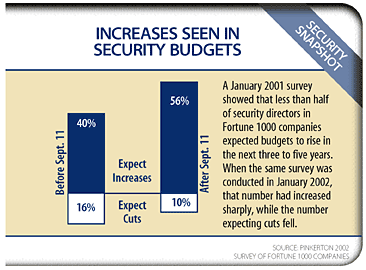
Health Care Facilities Rethink Security
Hospitals look to upgrade systems, educate staff; direct threats aren’t the only challenge
Although health care facilities may not be likely targets for terrorists, the attacks of Sept. 11 have prompted many to undertake a broad re-examination of their security needs.
The starting point is often access control. That’s a particular challenge because of the large number of access points. Complicating the situation is the fact that, by nature, hospitals are designed to be customer-friendly.
“People who only wish to cause problems are coming in with people who only want to visit a relative or friend,” says Bob Koverman, senior security consultant with Sako and Associates and past president of the International Association for Health Care Security and Safety.
The push for better security has brought CCTV systems, alarms and card reader systems to hospitals that never felt they needed those systems. Many older systems are being upgraded, with a growing number of facilities investigating biometrics. Even metal detectors have been appearing in some hospital entrances.
Surprisingly enough, some facilities don’t believe they are at risk because they are not in a high-profile building, prompting them to not pay much attention to their security needs. This is a mistake, says Koverman. “If you are a quasi-public facility, there is some amount of risk.”
Knowing this, many hospitals are also taking steps to secure HVAC systems and fuel tanks; bollards and barriers are becoming more commonplace. Concern about biological agents and mailroom security is also growing.
Of course, hospitals must also be prepared for any emergency in the community, including a response to a biological or chemical weapons attack. “Health care facilities feel vulnerable because they are the next line of defense for a disaster of any kind,” says Don DeBord, a vice president at RTKL. Koverman cites small rural hospitals that have renovated areas to create decontamination rooms, something only larger, centrally located facilities previously had.
While security has always been a part of the planning process, it often came up late in the design process. Today, security is increasingly a priority in the conceptual design stage. “It is easier to build security into planning and design than to renovate for it later,” says Bill McCarthy, associate vice president, RTKL. “The biggest thing that we need to educate executives about is that security isn’t something simply added on; it is integrated into the system.”
Educating people on how to think about security goes beyond infrastructure concerns. Health care workers must be aware of their surroundings, particularly with respect to people in the facility. Experts say that even simple steps such as approaching people who look out of place and asking if they need assistance can make a difference. “Facilities are looking at any issue that can improve their current situation,” says DeBord.
— Angela Maas, managing editor
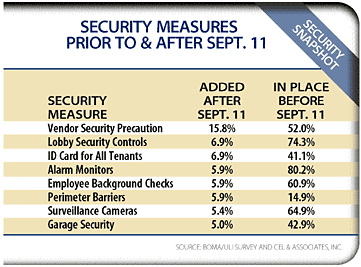
High-Tech Facilities Are Well Prepared
For data centers, security concerns and investment preceded attacks; labs evaluate additional measures
The owners of high-tech facilities have learned one lesson about security: When you find something good, you stick with it.
In an age when other facility executives are questioning their buildings’ security systems, most of those responsible for high-tech facilities like data centers, telecommunications facilities and laboratories could show off theirs.
“I’ve seen systems that even the federal government could be jealous of,” says Terry Gillick, vice president of Syska Hennessy Group.
Many data centers and telecom building exteriors and lobbies, for instance, are blast-proof with ballistic glazing up to 30 feet high. And that’s for facilities with windows. Many don’t have any. Rings of tight access control systems make it nearly impossible to go anywhere without proper clearance. Vehicles are kept at a distance, and sometimes even the exteriors are built with interstitial walls to further blast-proof the buildings. All of these facilities have protected their power supplies as well, while some are storing 30 to 60 days of diesel fuel for generators.
While many of these facilities were built in the 1990s when budgets were flush, Freidenfelds of Sako and Associates doesn’t see owners looking to water down security measures for new buildings even in these lean times.
The same can be said for corporate research laboratories. While the economy has slowed, interest in security for corporate labs has picked up. Since the events of last year, corporate labs have acted very progressively on security, says Mark Corey, principal with Flad and Associates.
“Immediately after the attacks, there was a rush to place barricades, restrict car access and implement card access systems,” Corey says. “More often than not, visitors, after being thoroughly checked and badged, have to be escorted to their destination.”
Over the past year there has been even more investment in long-term solutions such as isolating labs in a corporate campus with separate security systems, securing air intakes and reinforcing glazing. This is especially true if the labs are at the perimeter of the campus.
Is the move to extreme security at corporate labs a knee-jerk reaction? Corey doesn’t think so. “Sept. 11 was a wake-up call and the owners of these facilities are being prudent,” he says.
— David Kozlowski, senior editor
HVAC Systems Can Be Facilities’ Achilles Heel
Air intakes become top priorities; steps are available for existing buildings
Whether it’s a high-rise, hospital or shopping mall, one area of the building often least protected has been the HVAC system — at least until now. Today there is a great deal of interest in cost-effective ways to protect HVAC systems.
The air intake is the number one potential HVAC risk, not only for attacks but also for pranks and vandals. Moving the air intakes is cost-prohibitive for most existing buildings. “Air intakes on new buildings will no longer be at street level for high-rises, but I have not heard of anyone making a case for moving existing ones,” says Bogle of Ernst and Young.
An alternative is to restrict access to outdoor air intakes if possible, says Jerry Packham, project manager with Affiliated Engineers Inc. Owners are turning to fences or grills to restrict access, and some are also installing CCTV.
Another way owners can protect their air supply is to make sure the highest MERV-rated (Minimum Efficiency Reporting Value) filters appropriate for the system are installed. A higher-security option is HEPA filters. “A HEPA filter will trap particles down to 1 micron in size, and that comprises the majority of weapons-grade biological contaminants,” says Gillick of Syska Hennessy Group.
Filtration isn’t the ultimate solution, however. HEPA filters do not trap all the particles, and if even a few get through, the system has failed. Also, most air handlers and rooftop units can’t easily accommodate larger, more efficient filters.
Another step some owners have taken is to make sure all mechanical rooms are secure. At minimum, rooms should be locked, Packham says.
More costly measures may be justified if the risk is there. For instance, some Fortune 500 companies have installed UV systems in air handling units that kill biological contaminants in the air stream, Gillick says.
Packham recommends dedicated exhaust systems for mailrooms. Some facilities are also providing negative pressure in mailrooms and labs.
A strategy often used in laboratories is to dilute any chemical agent that might get into the air stream with an emergency exhaust of the area, Packham says. Some owners have been talking about using that sort of an approach for an entire building, with HVAC systems that will automatically shut down when a chemical contaminant is identified. But it’s tricky to design a system like that without endangering occupants.
Systems now coming on the market purport to capture and identify biological contaminants quickly enough that the HVAC system can respond to the attack, but these systems aren’t well tested. There are concerns about how fast the systems can detect a contaminant and how many contaminants they can reliably detect.
— David Kozlowski, senior editor
Related Topics:











